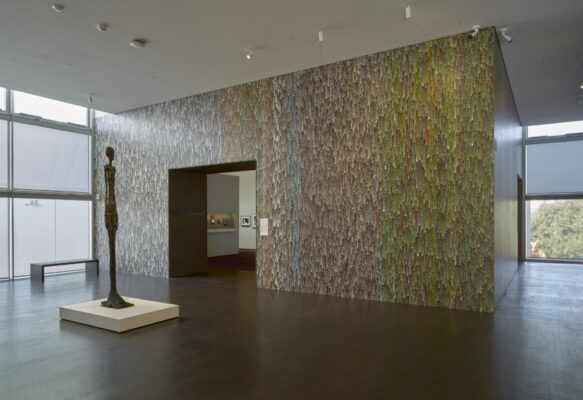Installation view of Jason Salavon’s Little Infinity, 2020. (Photo by Richard Barnes, Courtesy of the Museum of Fine Arts, Houston)
The Museum of Fine Arts, Houston opens the 237,000-square-foot Nancy and Rich Kinder Building on Saturday. (Photo by Richard Barnes, Courtesy of the Museum of Fine Arts, Houston)
The Museum of Fine Arts, Houston will celebrate a milestone this weekend with the opening on Saturday of the Nancy and Rich Kinder Building, a salute to the museum’s modern and contemporary collections, an addition that designates the city’s cultural landmark, measuring 14 acres, as the fourth largest museum campus in the country.
Whether traveling on Bissonnet or Main Street, one cannot miss the eye-catching trapezoidal design of the 237,000-square-foot building. Clad in translucent vertical glass tubes, the Kinder engages the imagination by day and emits a soft glow at night. Beyond the architecture, the site includes five rectangular courtyard pools that are inset along the perimeter, emphasizing the building’s openness to its surroundings.
Visitors will discover a transfixing world of modern and contemporary art across three floors in the expansive, light-filled galleries created by Steven Holl Architects. Amid the vast collections on display are treasured works by Alexander Calder, Franz Kline, Roy Lichtenstein and more from the late Caroline Wiess Law collection. Commissioned works by El Anatsui, Byung Hoon Choi, Carlos Cruz-Diez, Ólafur Elíasson, Trenton Doyle Hancock, Cristina Iglesias, Jason Salavon and Ai Weiwei are site-specific additions to the museum collection. Spotlighted are the works of Latin American modernist artists, the MFAH collection considered the most extensive in North America.
The collections on view include photography; prints and drawings; decorative arts, craft, and design; and modern and contemporary art.As many will recall, the Kinder building was named for philanthropists Nancy and Rich Kinder, who along with Susan and Fayez Sarofim, for whom the museum campus is named, contributed $150 million to the overall project.
“As proud as I am to be able to welcome you today,” Rich Kinder, MFAH board chair, said at the media opening on Monday, “I know I stand on the shoulders of many who came before me. We certainly can’t forget Peter Marzio, our long-term director who initially envisioned this project and also Caroline Wiess Law whose historic bequest in 2004 I think made clear to all of us who love this institution that we needed to think larger in both accessions and in physical space.”
In his assessment of the completion of the project, museum director Gary Tinterow noted, “In the dynamic spaces that Steven Holl Architects has designed for the Nancy and Rich Kinder Building, our distinctive holdings of modern and contemporary art now have the showcase they deserve. This area of our collection continues to grow rapidly, thanks to the exceptional endowment for acquisitions provided by our donors, with the late Caroline Wiess Law at the forefront.”
MFAH’s World
There are three entrances to the Kinder Building including a street side drop-off on Main Street and an entrance at Bissonnet and Main and then entrance via a lower level arrivals court. From the Beck building, visitors arrive underground via the Cruz-Diez tunnel and from the Glassell School garage via the Olafur Eliasson tunnel, both providing mind-bending color and light installations. Access is also possible from either level of the Kinder Garage.
Also, on the lower level, the Lynn Wyatt Theater shares space with the arrival hall.Somewhat as important as the new Kinder building is the connectivity between the three MFAH exhibition buildings which are linked by a landscape pattern emphasizing green spaces, designed by Deborah Nevins & Associates, in collaboration with Mario Benito. The Cullen Sculpture Garden, designed by Isamu Nagouchi in 1986, verdantly links the northern frontier of the Susan and Fayez Sarofim Campus just as the only-recently added oaks along the Bissonnet median extend the green conversation to the Caroline Wiess Law building. Add the massive oaks on Main Street that connect the Law building to the Audrey Jones Beck building across the street as a continuation of the nature esthetic.
In celebration of the Kinder opening, the museum will be open free to the public (timed reservations and masks required) November 21 to 25.

